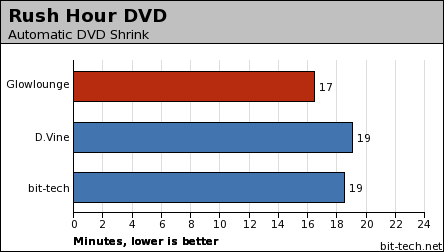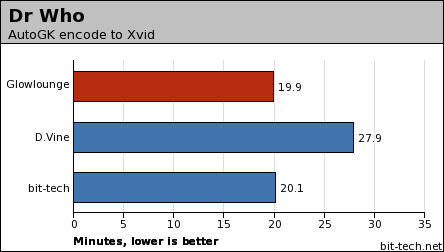
Performance
After throwing out the question of how you'd like us to test HTPCs, we came up with a fairly decent subjective and objective mix of benchmarks to run as our media system tests. The benchmarks are designed to stress the crucial parts of a Media Center system - the I/O and processing capabilities and they're designed to represent the kind of tasks you'd actually expect a media-centric system to do. In the future, we're also going to be adding video quality benchmarks, so stay tuned.For the benchmarks, we're comparing with our reference bit-tech rig. It sports an Athlon X2 3800+, 2GB DDR400 RAM, a Club 3D 7800GT, Maxtor 160GB hard drive, AOpen DVD writer and is housed in a Shuttle SN25P.
We're also comparing to the QuietPC D.Vine system that we reviewed a month or so ago.
High Definition content playback
Media Center uses WMV HD as the preferred high definition format for downloadable content. We went and grabbed the Terminator 2 trailer in 720P - the most common video size for HD content, at 1280x720. We used the performance management tools built into Windows XP to measure the average CPU usage across the playback of the trailer at full screen.
Music Importing and Encoding
Media Center has its own importing tools for getting music onto your hard drive. However, they're not particularly flexible in terms of encoding standards. We installed iTunes onto our machines and then ripped Moby - Play at 192k MP3. This test stresses both the ability of the CPU to deal with audio, and also the ability of the DVD drive in the system to keep the CPU fed.
Video sharing
One of the greatest abilities of a HTPC is the ability to store all your movies in one place. Never mind toting DVDs around the house: putting them on your central machine and having them accessible at the touch of a button is a nifty feature, and this accessibility is made easy in Media Center with the My Videos function. For this test, we used DVD Shrink to do an Automatic shrink of our Rush Hour DVD. However, take note: the legality of video sharing may vary depending on where in the world you live.
TV encoding
Of course, you're going to want to record and save your favourite TV programmes on your HTPC. Media Center records and stores in MPEG 2, the same format that DVB-T television is transmitted in. To test the video encoding prowess of the systems, we recorded a 15-minute segment of Dr Who using Media Center, then encoded it to Xvid using AutoGK.
Subjective use
As you'd expect, the system absolutely flies along in general usage. With a 3800+ sitting at the heart of the machine, there's absolutely no problems multitasking and handling recording/playback simultaneously. You can even do a decent bit of hi-res gaming with the 6600 included. We were easily able to rip a CD, record a TV channel and watch another programme without stuttering. The machine also coped well with 720p high definition content. Dual core is really essential for MCE PCs if you want to multitask, especially with high definition content.The 320GB drive will be plenty of space for most people, and there's actually a spare 3.5" hard drive bay in the machine for you to add in extra storage if you really need to - although beware of heat concerns.
Connectivity
The system features a gigabit ethernet port courtesy of the nForce 4 chipset. There's no wireless included, but there is a spare expansion slot for you to put a card in if you need it.Perhaps the most awesome thing about this system is that you can use the onboard 6150 graphics along with the add-in card if you go into the BIOS and enable the onboard chip, which is disabled by default. This will allow you to use the system as a multi-monitor work-bitch with minimum hassle.

MSI MPG Velox 100R Chassis Review
October 14 2021 | 15:04





Want to comment? Please log in.